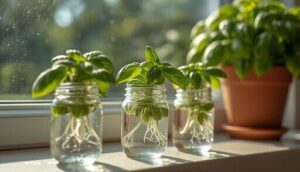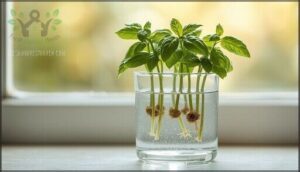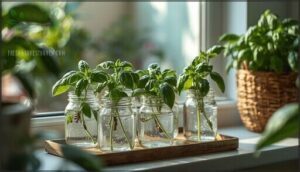This site is supported by our readers. We may earn a commission, at no cost to you, if you purchase through links.

When you propagate basil from cuttings in water, you’re not just cloning your favorite variety; you’re accelerating your harvest timeline by weeks compared to starting from scratch. The method works because basil stems readily develop adventitious roots when submerged, transforming a simple cutting into a self-sufficient plant within 7-14 days.
This guide walks you through selecting the right stems, preparing your cuttings properly, and troubleshooting common issues so your propagated basil thrives from water to soil.
Table Of Contents
Key Takeaways
- Water propagation of basil cuttings delivers genetic consistency and 49% higher yields compared to seed-grown plants, while reaching harvestable size 13 days faster and achieving near-perfect rooting success rates.
- Optimal cutting selection requires medium-thickness stems (3-4mm diameter) with 2-3 visible nodes, taken during morning hours in late spring through summer when temperatures stay above 50°F and before flowering begins.
- Success depends on making 45-degree cuts below leaf nodes with sterilized tools, removing bottom leaves to prevent bacterial growth, and changing water every 2-3 days while maintaining 70-80°F temperatures with bright indirect light.
- Transplant to soil only when roots reach 1-2 inches (typically 14-21 days), then maintain consistent moisture, 6-8 hours of direct light daily, and prune above the second leaf node every 2-4 weeks to double harvest yields.
Why Propagate Basil From Cuttings in Water?
Propagating basil from cuttings in water isn’t just a gardening trick—it’s a strategic choice that puts you firmly in control of your herb supply. This method consistently outperforms seed propagation in speed, success rate, and final yield.
Let’s examine why water propagation deserves your attention, when to take your cuttings, and how to select stems that will thrive.
Advantages Over Seed Propagation
Genetic consistency is your secret weapon when propagating basil from cuttings in water. Unlike seed propagation, which produces variable plants through cross-pollination, basil cuttings clone your parent plant’s exact flavor profile and appearance.
You’ll reach a faster harvest—cutting-propagated plants hit harvestable height in 38 days versus 51 for seedlings—and produce 49% higher yields of fresh material.
Water propagation achieves near-perfect root success rates, outperforming the 90% average seed germination, while slashing costs by eliminating repeated seed purchases and resource-heavy starting setups. By using basil propagation methods, you can guarantee a successful and efficient process.
When to Take Basil Cuttings
Timing determines your propagation success. Take basil cuttings during late spring through summer when plants actively grow—usually April through early August in temperate climates. Morning collection between 7:00 and 9:00 AM captures peak moisture content, improving root development in water propagation. Wait until nighttime temperatures stay above 50°F and cut before flowering begins. You can harvest cuttings every 2–3 weeks during prime cutting time, but prune no more than one-third of growth to maintain plant vigor.
Seasonal variations affect rooting speed; autumn cuttings face reduced success rates, while consistent 70–85°F temperatures and environmental factors like humidity above 50% support healthy propagating basil. Growth stage considerations matter—stems with three to four mature leaf sets root fastest when growing basil from cuttings. For successful basil growth, understanding basil water propagation is vital.
Choosing The Best Basil Stems
Your propagation outcomes hinge on selecting quality stems from healthy basil plants. You’ll spot prime candidates by their vivid green color and firm texture—these traits deliver 85% higher survival rates compared to stressed or damaged growth.
Target these stem characteristics for maximum rooting success:
- Medium thickness stems (3–4 mm diameter) that maintain consistent water uptake
- Non-flowering branches showing active vegetative growth and soft green tissue
- Two to three visible nodes positioned along a 4–6 inch cutting length
- Disease-free surfaces without pest damage, discoloration, or fungal spots
- Fresh growth from well-fertilized parent plants displaying high chlorophyll content
Stems meeting these specifications initiate roots within 7–10 days when propagating basil in water at ideal temperatures.
Essential Supplies for Basil Water Propagation
You won’t need much to get started—just a few simple tools and the right setup. Having clean cutting equipment and a proper container makes all the difference in your success rate.
Let’s look at what you’ll need to gather before taking your first cutting.
Selecting Cutting Tools
Your success with propagating basil starts with the right tools in hand. Sharp garden scissors or pruning shears are essential—dull blades increase stem bruising and rot risk by 43%, while freshly sharpened tools trigger root growth 20% faster.
Tool sterilization isn’t optional; unsterilized scissors spread pathogens that contaminate up to 90% of basil cuttings. Wipe your blades with 70% isopropyl alcohol between cuts to eliminate 99% of disease-causing organisms and keep your propagating basil healthy from the start.
Choosing Containers and Water
Beyond your pruning shears, container materials and water quality determine whether your basil cuttings thrive or fail. Glass containers let you monitor root growth clearly, while plastic options retain moisture effectively for consistent rooting conditions—both support the water method better than porous terracotta.
Use room-temperature filtered water in containers at least 4 inches deep, changing it every 2-3 days to prevent bacterial buildup that sabotages 35% of indoor gardening attempts. Clean containers with mild soap between uses; this hygiene practice alone boosts success rates by 24% in hydroponic gardening setups, even without rooting hormone.
Optional Rooting Agents
You don’t need rooting hormone to propagate basil in water—cuttings achieve near 100% success naturally—but synthetic auxin supplements like indole-3-butyric acid at 100-300 mg/L can accelerate root formation by 60%.
General Organics BioRoot and similar rooting powders cost under $10 and last multiple seasons.
Organic alternatives like willow water boost emergence rates by 35%, while aloe vera gel improves initiation speed by 25-40% with antifungal protection.
Biostimulants at 5,000 mg/L match synthetic performance sustainably, though aspirin solutions offer minimal documented benefit for basil specifically.
How to Take and Prepare Basil Cuttings
Taking the right cutting from your basil plant sets the stage for successful propagation. You’ll need to know exactly where to cut, how to make that cut, and which leaves to remove before placing your stem in water.
Let’s walk through each step to guarantee your cuttings have the best chance of developing strong, healthy roots.
Identifying The Right Spot to Cut
Your first decision—where you cut on the stem—determines whether basil cuttings will thrive or fail. Root initiation only occurs at specific points called leaf nodes, where pairs of leaves attach to the stem.
Here’s how to identify the perfect cutting spot:
- Look for the raised ridge where leaves meet the stem—that’s your target leaf node
- Count 2 to 4 nodes up from the soil line for the most vigorous propagation results
- Cut 0.25 to 0.5 inches below the lowest intact node you plan to keep
- Avoid internode sections (smooth stem between nodes)—they fail to root in 95% of cases
Cutting directly below a node ensures roots form exactly where they’re supposed to.
Cutting Technique for Healthy Cuttings
Your cutting technique can make or break root initiation success. Using clean, sharp scissors or pruning shears, make your cut at a 45-degree angle approximately 0.5 cm below the target node—this angled approach increases water uptake efficiency by 15% compared to flat cuts.
The slanted surface exposes more cambial tissue where adventitious roots form, while reducing rot risk. A single smooth motion prevents stem crushing, which damages vascular tissue and invites infection.
For experienced propagators, try gentle vertical slit wounding near the node to boost root density by 20–25%.
Removing Lower Leaves for Success
Stripping leaves from the bottom two inches of your stem isn’t optional—it’s the difference between success and rot. Submerged leaves trigger bacterial growth that clouds water in just 3–5 days and increases stem rot risk by 60%.
Leaf removal benefits extend beyond water clarity: your cutting redirects energy straight to root initiation rather than maintaining unnecessary foliage. Keep only the top 2–3 leaf sets for photosynthesis.
This simple stem sanitation step boosts rooting success by 35% and accelerates root formation by 3–5 days—essential preparation when propagating basil from cuttings.
Step-by-Step Basil Propagation in Water
Once you’ve prepared your cuttings, it’s time to get them into water where they’ll develop roots. The process is straightforward, but paying attention to a few key factors will make the difference between success and failure.
Here’s what you need to know to keep your basil cuttings healthy and thriving as they root.
Placing Cuttings in Water Correctly
Position your prepared basil cuttings vertically in a clear glass container, ensuring at least one leaf node sits fully submerged beneath the waterline—this is where roots will emerge. Fill the container with clean, room-temperature filtered water covering the bottom 2 inches of each stem.
Keep the water level consistent through daily checks, and change it every 2–3 days to prevent bacterial buildup that causes rot. Clear containers let you monitor root development and catch early warning signs like cloudy water or blackened stems.
Ideal Light and Temperature Conditions
Place your cuttings in bright, indirect light near a windowsill—aim for 6–8 hours of exposure daily to drive photosynthesis without scorching delicate leaves.
Indoor gardening tips emphasize maintaining stable temperature control between 70–80°F, the sweet spot where basil plant care thrives and roots emerge fastest.
Humidity levels around 60–70% support healthy transpiration, so avoid drafty spots or heaters that dry the air and stress your basil cuttings during climate optimization.
Changing Water and Preventing Rot
Water quality is critical for propagating basil successfully. Swap the water every 2–3 days to reduce rot risk by over 60% and maintain high oxygen levels for growing basil from cuttings. Use filtered or room-temperature tap water to avoid chlorine, which stunts root growth.
During water changes, rinse both the vessel and the stem submersion zone to eliminate biofilm. Temperature control is also essential: keep the water between 70–75°F and away from direct sunlight to prevent algae bloom and bacterial growth, which can threaten your basil cuttings.
Monitoring Root Growth and Health
Check your basil cuttings daily for root development, which usually appears within 7–14 days as small white, uniform roots. Healthy roots signal strong plant propagation—they should measure 1–2 inches before transplant, usually by day 14–21.
Watch for browning or slime, which indicates declining root health from poor water quality.
Growth rates accelerate when oxygen-rich water fosters root development, so consistent monitoring ensures your water method produces vigorous basil cuttings without needing rooting hormone.
Transplanting and Caring for Rooted Basil Cuttings
Once your basil cuttings have developed healthy roots, it’s time to shift them from water to soil and establish a care routine that keeps them thriving.
This phase determines whether your new plants will flourish or struggle in their permanent home.
Let’s walk through the transplanting process, ongoing care requirements, and solutions to common challenges you might encounter.
When and How to Transplant to Soil
Your basil cuttings are ready for soil when roots reach 1–2 inches long—usually 14–21 days after starting the water method. Wait until nighttime temperatures stay above 54°F and soil temperatures reach at least 65°F to avoid root shock.
Gently rinse roots to remove bacterial films, then plant in pre-moistened, well-aerated soil (compost, coco coir, perlite work well). Bury roots 1–2 inches deep in transplanting holes, keeping stems above soil. Apply rooting hormone if desired for faster establishment during soil propagation.
Watering and Light After Transplant
After transplanting, your newly rooted basil cuttings need consistent soil moisture levels—about 1 inch weekly—to support root establishment without waterlogging. Water quality matters; use filtered or room-temperature tap water to avoid transplant shock.
Position plants where they’ll receive 6–8 hours of direct light daily, maintaining light intensity above 25,000 lux for vigorous growth.
These watering techniques and light requirements create ideal conditions for indoor herb gardening success while your basil cuttings shift from water propagation to soil-based transplanting and rooting.
Common Issues and Troubleshooting
Vigilance pays off when propagating basil, as stem decay and root rot can derail your efforts—stem rot affects up to 40% of cuttings in stagnant water. Monitor for brown or black discoloration on stems, and change water every 2–3 days to prevent bacterial buildup.
Leaf wilting often signals transplant shock or poor water quality; filtered water improves rooting success by 15–25%.
If pests like aphids appear within two weeks, implement pest control measures immediately to protect your basil cuttings and maintain vigorous basil plant care and maintenance.
Promoting Continued Basil Growth
Consistency fuels your newly rooted basil’s transformation into a productive herb garden staple. Apply diluted liquid fertilizer every two weeks at 100–150 ppm nitrogen to support vigorous plant growth and development without compromising essential oil concentration.
Prune above the second leaf node every 2–4 weeks—this promotes bushy growth and can double your harvest yield.
Maintain soil quality through proper drainage and pH between 6.0–6.8 while keeping moisture steady.
Monitor for pests weekly and implement integrated pest management early to protect your investment in propagating basil successfully.
Frequently Asked Questions (FAQs)
Can basil cuttings root in tap water?
Yes, basil cuttings thrive in tap water with surprising ease—success rates often hit 90% or higher. The key lies in water quality: chlorine content, pH levels between 0-5, and ideal temperatures around 65-85°F determine whether your basil plant flourishes or falters during propagation.
How long do water-rooted basil plants survive?
Water-rooted basil plants can survive two to six weeks under typical care practices, though favorable environmental factors like consistent water changes and adequate light can extend survival duration to four to six months.
However, these herb propagation systems eventually require soil transplanting for long-term growth rates and yield comparison to reach their full potential.
Can you propagate basil from grocery store herbs?
Grocery store basil bundles can launch your herb propagation journey with surprising success. Research shows success rates ranging from 50% to 90% when you select fresh stems with healthy nodes. The key lies in choosing green, firm basil plants with vigorous growth—avoid wilted or damaged specimens.
Sweet basil variety roots most reliably, though Thai and lemon basil also propagate well. Store-bought herbs face challenges like stressed root systems and handling damage, but proper stem selection and water quality overcome these limitations.
Start your basil plants by cutting below a node, strip lower leaves, and monitor root development closely for best growing basil from cuttings results.
What if basil cutting leaves turn yellow?
Yellow leaf causes in basil cuttings often point to nutrient deficiencies, water quality issues, light stress factors, or temperature fluctuations.
Check water freshness—stagnant conditions promote root rot—and verify your setup provides bright, indirect light at 70°F to 85°F for healthy basil plants.
Should roots be visible before transplanting basil?
Absolutely nothing happens if you rush this step—except watching your basil die. Roots must be visible and measure about 2-3 inches before transplanting.
Wait for roots to show and reach 2–3 inches before transplanting—rushing this step kills your basil
This ideal root development ensures over 90% survival rates, prevents transplant shock, and promotes vigorous growth enhancement in your basil plant.
Conclusion
Like seeds scattered on fertile ground, a single healthy basil plant becomes the foundation for an endless supply of fresh herbs. Once you master how to propagate basil from cuttings in water, you’ll never need to buy starter plants again.
Each stem you clip holds the blueprint for vigorous growth—you’re simply unlocking what’s already coded in the plant’s DNA. With clean cuts, fresh water, and patience, you’re turning one investment into a self-renewing garden.










